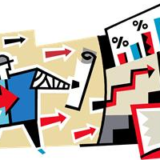
Big data, machine learning, connected vehicles, Industry 4.0, robotic process automation, blockchain …. And many other ways to describe digital transformation as an emerging opportunity to transform every industry at a scale comparable to the mechanization of agriculture.
Several companies including Amazon, Alibaba, Burberry, Samsung, Disney are leading the transformation wave. Results include creation of new businesses such as Michelin’s Efifuel to increase revenues by 10-25% as well as productivity improvements greater than 30% at Schneider Electric. However, a recent McKinsey survey indicates that only four to 11 percent of companies report success reaching the promised land of digital transformation – measured in terms of results improvement and/or the time to get there. Our view is that this occurs by treating Digital transformation essentially as an IT initiative focused on the “flash” from the many software vendors plying this space versus a holistic step-change transition of business process, operating model, governance and culture.
Beyond today’s digital transformation success stories, the best place to look for lessons learned are prior large-scale transformations such as the development of China as the world’s manufacturer, which fundamentally changed the way companies operated. The common themes were that success takes sustained top-down commitment, active participation from every person in the organization and the value chain, a willingness to experiment, a flexible and creative culture in designing and working in a new operating model (that may for a time work in parallel with the older operating model), a focus on change management at the executive, manager and front-line employee level as well as rigorous governance to keep the transition on track – in other words, a “village” approach.
This “village” can provide the necessary support for every part of your company’s value chain to change as Digital Transformation becomes the way of life. Without it, success is determined by the weakest link. In our view, in addition to the role of senior management in spear-heading the change, the core of the village consists of:
- Human Resources function who will need to be the champions of change management across the organization by
- Helping Front-line employees address two challenges – reduction in number and/or need for higher order skills. g. on the factory floor, operators will need to be skilled in working with Artificial Intelligence advisors that prompt them proactively to optimize operations.
- Helping Managers transition to be more like coaches and trainers to get the most out of the smaller number of people in their teams. And to get increasingly comfortable empowering lower levels of the organization to make decisions.
- Helping Executives learn how to lead innovation in strategizing and planning not only each step of the digital transformation but also a multi-year master plan that imagines and incorporates emerging technologies and tools.
- Developing an organization structure and operating model with the right roles and responsibilities in place for a digitally enabled business, including ruthless out-sourcing of non-critical functions
- Proactively identifying and addressing key talent gaps e.g. data scientists.
- Encouraging a shared sense of responsibility and accountability for Digital Transformation across the organization
- Finance function who will need to be the champions of financial discipline in the near-term and longer-term by
- Ensuring that all digital initiatives are set-up to be ROI accretive – with gates to make mid-course corrections as needed
- Setting up the right metrics and governance to drive accountability at the right levels of the organization – whether by operating unit (plant/store), business function, geographic region and/or product / service offering
- Not letting funding or cash flow become a constraint for digital transformation
- Information technology function who will need to go beyond selecting best-fit vendors / tools to
- Make data visibility, organization, storage and access everyone’s role
- Work with every part of the business to help prioritize the right sequence for digital transformation
- Aggressively hold vendors to their commitments to deliver benefits
- Proactively address digital challenges e.g. cyber security threats at a product or process level
- All leaders of operating units / functions in your company who will need to
- Visibly champion the transition (individually and collectively)
- Prioritize the areas that are likely to benefit the most from digital transformation
- Help their teams assess and overcome the myriad issues that are likely to come up as Digital Transformation gains momentum
- Work collaboratively across operating unit / functional boundaries to reach the best solution for the company
- Suppliers and partners who need to understand what your company is doing and work with their counter-parts to accelerate progress across the entire supply chain
In summary, success is neither easy nor guaranteed in reaching the full potential of Digital Transformation. A top-down strategy that makes every function / operating unit in your company’s “village” an equal and accountable participant is driving transition to the promised land, increases your company’s chances to accelerate competitive differentiation.











